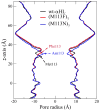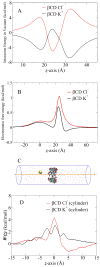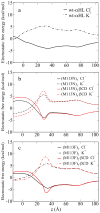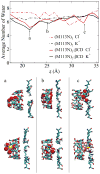Ion selectivity of alpha-hemolysin with a beta-cyclodextrin adapter. I. Single ion potential of mean force and diffusion coefficient
- PMID: 20041673
- PMCID: PMC2847479
- DOI: 10.1021/jp906790f
Ion selectivity of alpha-hemolysin with a beta-cyclodextrin adapter. I. Single ion potential of mean force and diffusion coefficient
Abstract
The alpha-hemolysin (alphaHL) is a self-assembling exotoxin that binds to the membrane of a susceptible host cell and causes its death. Experimental studies show that electrically neutral beta-cyclodextrin (betaCD) can insert into the alphaHL channel and significantly increase its anion selectivity. To understand how betaCD can affect ion selectivity, molecular dynamics simulations and potential of mean force (PMF) calculations are carried out for different alphaHL channels with and without the betaCD adapter. A multiscale approach based on the generalized solvent boundary potential is used to reduce the size of the simulated system. The PMF profiles reveal that betaCD has no anion selectivity by itself but can increase the Cl(-) selectivity of the alphaHL channel when lodged into the pore lumen. Analysis shows that betaCD causes a partial desolvation of ions and affects the orientation of nearby charged residues. The ion selectivity appears to result from increased electrostatic interaction between the ion and the channel due to a reduction in dielectric shielding by the solvent. These observations suggest a reasonable explanation of the ion selectivity and provide important information for further ion channel modification.
Figures









Similar articles
-
Ion selectivity of alpha-hemolysin with beta-cyclodextrin adapter. II. Multi-ion effects studied with grand canonical Monte Carlo/Brownian dynamics simulations.J Phys Chem B. 2010 Mar 4;114(8):2901-9. doi: 10.1021/jp906791b. J Phys Chem B. 2010. PMID: 20146515 Free PMC article.
-
Reversal of charge selectivity in transmembrane protein pores by using noncovalent molecular adapters.Proc Natl Acad Sci U S A. 2000 Apr 11;97(8):3959-64. doi: 10.1073/pnas.97.8.3959. Proc Natl Acad Sci U S A. 2000. PMID: 10760267 Free PMC article.
-
Prolonged residence time of a noncovalent molecular adapter, beta-cyclodextrin, within the lumen of mutant alpha-hemolysin pores.J Gen Physiol. 2001 Nov;118(5):481-94. doi: 10.1085/jgp.118.5.481. J Gen Physiol. 2001. PMID: 11696607 Free PMC article.
-
Ion channels and bacterial infection: the case of beta-barrel pore-forming protein toxins of Staphylococcus aureus.FEBS Lett. 2003 Sep 18;552(1):54-60. doi: 10.1016/s0014-5793(03)00850-0. FEBS Lett. 2003. PMID: 12972152 Review.
-
alpha-Hemolysin from Staphylococcus aureus: an archetype of beta-barrel, channel-forming toxins.J Struct Biol. 1998;121(2):110-22. doi: 10.1006/jsbi.1998.3959. J Struct Biol. 1998. PMID: 9615434 Review.
Cited by
-
Microsecond simulations of DNA and ion transport in nanopores with novel ion-ion and ion-nucleotides effective potentials.J Comput Chem. 2014 Apr 5;35(9):711-21. doi: 10.1002/jcc.23544. J Comput Chem. 2014. PMID: 24738152 Free PMC article.
-
Close encounters with DNA.J Phys Condens Matter. 2014 Oct 15;26(41):413101. doi: 10.1088/0953-8984/26/41/413101. Epub 2014 Sep 19. J Phys Condens Matter. 2014. PMID: 25238560 Free PMC article. Review.
-
BROMOC-D: Brownian Dynamics/Monte-Carlo Program Suite to Study Ion and DNA Permeation in Nanopores.J Chem Theory Comput. 2012 Jul 10;8(7):2540-2551. doi: 10.1021/ct3004244. Epub 2012 May 24. J Chem Theory Comput. 2012. PMID: 22798730 Free PMC article.
-
Membrane Position Dependency of the pKa and Conductivity of the Protein Ion Channel.J Membr Biol. 2018 Jun;251(3):393-404. doi: 10.1007/s00232-018-0013-3. Epub 2018 Jan 16. J Membr Biol. 2018. PMID: 29340712 Free PMC article.
-
Dissecting current rectification through asymmetric nanopores.Biophys J. 2025 Feb 18;124(4):597-603. doi: 10.1016/j.bpj.2024.11.3318. Epub 2024 Nov 29. Biophys J. 2025. PMID: 39614613
References
-
- Laestadius A, Richter-Dahlfors A, Aperia A. Kidney Int. 2002;62:2035–2042. - PubMed
-
- Gentschev I, Dietrich G, Goebel W. Trends in Microbiology. 2002;10:39–45. - PubMed
-
- Rowe SM, Miller S, Sorscher EJ. New England Journal of Medicine. 2005;352:1992–2001. - PubMed
-
- Gouaux E. J Struct Biol. 1998;121:110–122. - PubMed
Publication types
MeSH terms
Substances
Grants and funding
LinkOut - more resources
Full Text Sources

